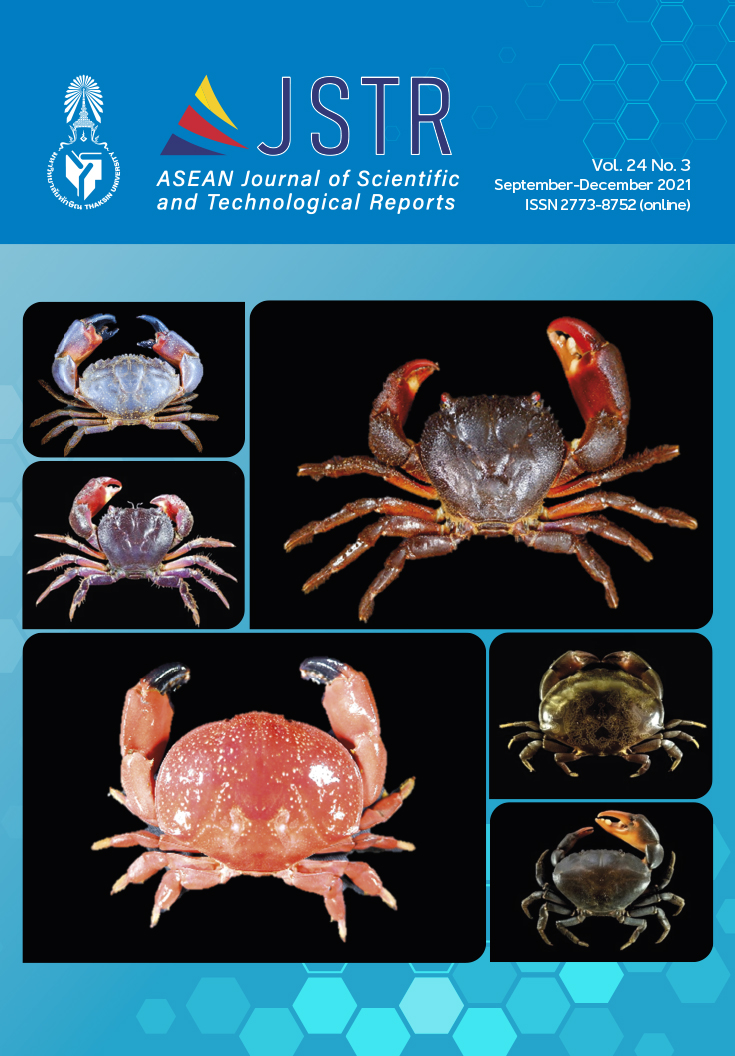Effect of Sweet Cassava Flour and Rice Flour on Physical Properties and Sensory Evalu-ation of Gluten-Free Takoyaki Product
Main Article Content
Abstract
The objective of this research was to investigate the effect of substitution of wheat flour with sweet cassava flour and rice flour on physical and sensory qualities in a gluten-free Takoyaki. The different ratios of cassava flour and rice flour were performed at five recipes, including 55:45 (HN55), 65:35 (HN65), 75:25 (HN75), 85:15 (HN85) and 100:0 (HN100) and then analyzed their quality attributes. These results indicated that increasing the ratio of cassava flour in Takoyaki products revealed the decrease in hardness (p ≤ 0.05) and the colour of products were a darker brown with lightness (L*) redness (a*) but yellowness (b*) was de-creased (p ≤ 0.05). Next, the sensory evaluation suggested that an increase of ra-tios of cassava flour was also significantly reduced in the likeness score in ap-pearance, colour, crispness, softness, oiliness, and overall liking (p ≤ 0.05) by us-ing a 9-point hedonic scale. This work clearly shows that HN55 is like Takoyaki from wheat flour (as control) since the sensory evaluation has been indicated at like moderately to very much. So, the sweet cassava flour is potentially used to prepare gluten-free products, but it may be necessary to improve due to some containing the specific odour.
Article Details

This work is licensed under a Creative Commons Attribution-NonCommercial-NoDerivatives 4.0 International License.
References
Ready Meals: Worldwide Market Growth & Trends 2018-2023 - Frozen Ready Meals Dominate the Global Market With a Share of More Than 52%. Available online: https://prn.to/2lIxGqt (accessed on 22 October 2020).
Roman, L.; Belorio, M.; Gomez, M. Gluten‐free breads: The gap between research and commercial reality. Comprehensive Reviews in Food Science and Food Safety. 2019, 18, 690-702.
The Secretary-General of the OECD. Cassava (Manihot esculenta). In Safety Assessment of Transgenic Organisms in the Environment. OECD: OECD Consensus Documents, Paris, 2016; 6, 155-186.
ISFAS Project in Thailand-The Study of Cassava Supply Chain in Kanchanaburi Province, Thailand. Available online: http://www.aptfsis.org/project/3 (accessed on 22 October 2020).
Shittu, T.A.; Raji, A.O.; Sanni, L.O. Bread from composite cassava-wheat flour: I. Effect of baking time and temperature on some physical properties of bread loaf. Food Research International. 2007, 40, 280-290.
Charoenkul, N.; Uttapap, D.; Pathipanawat, W.; Takeda, Y.; Physicochemical characteristics of starches and flours from cassava varieties having different cooked root textures. LWT-Food Science and Technology. 2011, 44, 1774-1781.
Pérez, E.; Pérez, L. Effect of the addition of cassava flour and beetroot juice on the quality of fettuccine. Afri-can Journal of Food Science. 2009, 3, 352-360.
Aniedu, C.; Omodamiro, R.M. Use of newly bred β-carotene cassava in production of value-added products: Implication for food security in Nigeria. Global Journal of Science Frontier Research Agriculture and Veterinary Sciences. 2012, 12, 1-10.
Steenkamp, V.; McCrindle C.M. Production, consumption and nutritional value of cassava (Manihot escu-lenta, Crantz) in Mozambique: An overview. Journal of Agricultural Biotechnology and Sustainable Development. 2014, 6, 29-38.
Goesaert, H.; Brijs, K.; Veraverbeke, W.S.; Courtin, C.M.; Gebruers, K.; Delcour, J.A. Wheat flour constituents: how they impact bread quality, and how to impact their functionality. Trends in food science & technology. 2005, 16, 12-30.
Jensen, S.; Skibsted, L.H.; Kidmose, U.; Thybo, A.K. Addition of cassava flours in bread-making: sensory and textural evaluation. LWT-Food Science and Technology. 2015, 60, 292-299.
Barutcu, I.; Sahin, S.; Sumnu, G. Effects of microwave frying and different flour types addition on the micro-structure of batter coatings. Journal of Food Engineering. 2009, 95, 684-692.
Guerrero, S.; Alzamora, S.M.; Gerschenson, L.N. Optimization of a combined factors technology for pre-serving banana purée to minimize colour changes using the response surface methodology. Journal of Food Engineering. 1996, 28, 307-322.
Castañón, X.A.A.; Lopez-Malo A. Effect of storage temperature on the microbial and color stability of bana-na purée with addition of vanillin or potassium sorbate. Food Science Technology International. 1999, 5, 51-58.
Eke-Ejiofor, J.; Beleya, E.A. Chemical, mineral, pasting and sensory properties of spiced ogi (gruel). American Journal of Food Science and Technology. 2017, 5, 204-209.
Kim, Y.S.; Lee, Y.T.; Seok, H.M. Physicochemical properties of starches from waxy and non-waxy hull-less barleys. Journal of the Korean Society of Agriculture Chemistry and Biotechnology. 1999, 42, 240-245.
Gray, D.; Abdel-Aal, E.S.M.; Seetharaman, K.; Kakuda, Y. Differences in viscosity and textural properties of selected barley cultivars as influenced by pearling and cooking. Food Chemistry. 2010, 120, 402-409.
Oladunmoye, O.O.; Aworh, O.C.; Maziya‐Dixon, B.; Erukainure, O.L.; Elemo, G.N. Chemical and functional properties of cassava starch, durum wheat semolina flour, and their blends. Food Science & Nutrition. 2014, 2, 132-138.
Eriksson, E.; Koch, K.; Akonor, P.T.; Oduro-Yeboah, C. Evaluation of the physical and sensory characteris-tics of bread produced from three varieties of cassava and wheat composite flours. Food and Public Health. 2014, 4, 214-222.
Ketjarut, S.; Pongsawatmanit, R. Influence of tapioca starch on thermal properties of wheat flour-based bat-ter and quality of fried battered chicken wingsticks. International Journal of Food Engineering. 2015, 11, 641-650.
Mallikarjunan, P.; Ngadi, M.O.; Chinnan, M.S. Breaded fried foods, 1st ed.; CRC Press: New York, The United States of America. 2010; 81–85.


